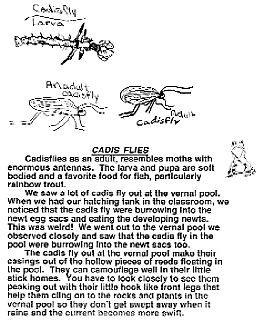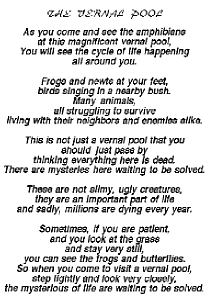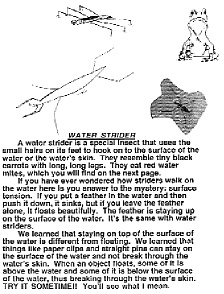Once
a
teacher
has
established
a
foundation
for
doing
inquiry
in
the
classroom,
science
learning
can
take
some
unexpected
paths.
This
essay
follows
the
experiences
of
a
fifth-grade
teacher
who
allowed
her
class
to
pursue
their
questions
and
interests.
The
result
was
a
full-year
inquiry
investigation
that
gave
students
insights,
knowledge,
and
experiences
that
far
exceeded
their
teacher's
expectations.
Beth
is
a
fifth-grade
teacher
in
a
suburban
school
in
northern
California.
Over
the
past
3
years,
she
has
been
experimenting
with
inquiry
in
her
classroom.
Beth
has
moved
toward
inquiry
incrementally,
designing
lessons
and
strategies
that
build
a
foundation
for
doing
short-term
(several-day)
student
investigations.
Last
year,
Beth
decided
to
embark
on
a
month-long
inquiry
investigation.
Quite
by
accident,
the
investigation
grew
into
a
year-long
study
as
Beth
followed
the
expanding
curiosities
and
interests
of
her
students.
Beth's
regular
science
curriculum
includes
a
unit
on
the
study
of
diverse
ecosystems
and
interdependency.
As
part
of
this
study,
she
introduces
her
students
to
a
nearby
vernal
pool--a
seasonal
pond
that
fills
with
rainfall
and
attracts
amphibians,
aquatic
insects,
and
vegetation.
Beth
hopes
to
develop
her
students'
appreciation
and
stewardship
of
this
unique
and
precious
local
habitat.
During
the
first
several
months
of
the
year,
Beth
creates
a
framework
from
which
students
develop
process
and
social
skills.
These
skills
are
designed
to
allow
students
to
carry
out
productive
investigations
in
which
deep,
significant
conceptual
learning
takes
place.
By
the
time
the
vernal
pool
has
filled
with
winter
rain,
Beth
wants
the
students
to
be
equipped
with
the
process
skills
and
previous
knowledge
that
will
allow
them
to
investigate
in
a
scientific
manner.
Beth
draws
upon
her
existing
curriculum
on
the
environment
and
uses
other
topics
of
study
that
are
required.
Since
Beth
knows
that
inquiry
begins
with
looking
closely,
she
focuses
considerable
time
on
the
skill
of
observation.
Lessons
are
planned
around
the
use
of
tools
for
observing,
such
as
microscopes
and
hand
lenses.
Students
spend
time
studying
fish
in
an
aquarium,
learning
to
pay
attention
to
and
describe
details
and
differences.
Because
questioning
is
a
central
part
of
exploring
and
understanding
the
environment,
specific
lessons
focus
on
the
art
of
asking
questions.

"Cadis
Flies,"
courtesy
Beth
Kraft's
fifth-grade
classroom,
Lu
Sutton
Elementary
School,
Novato,
California.
Beth
wants
her
students
to
begin
recognizing
the
kinds
of
questions
that
lead
to
experimentation,
as
opposed
to
those
that
cannot
be
answered,
or
those
that
have
to
be
answered
by
asking
experts
or
reading
books.
When
teaching
literature
or
social
studies,
Beth
takes
opportunities
to
make
connections
between
the
way
questions
are
used
to
develop
understanding
in
these
disciplines
and
how
her
students
can
ask
useful
questions
in
their
own
studies.
The
students
are
taught
how
to
keep
records
through
writing,
drawing,
graphing,
and
charting.
Often,
Beth
found
that
similar
skills
were
being
used,
and
relationships
made,
in
math
activities.
She
works
with
the
students
on
controls,
variables,
and
fair
tests.
Throughout
this
period
of
time,
they
are
also
taught
the
language
of
science.
"I
want
them
to
understand
what
they
are
practicing,"
Beth
says.
"And
that
they
are
beginning
to
think
like
scientists."
To
further
prepare
for
investigations
at
the
vernal
pool,
the
class
spends
time
gathering
information
about
ecosystems
and
the
interdependency
of
plants
and
animals
in
the
environment.
Beth
invites
guest
speakers
to
talk
about
freshwater
ecosystems
and
storm
drain
systems.
The
students
do
research
by
reading
books,
looking
up
information
on
the
Internet,
and
watching
videos.
They
do
a
series
of
focused
experiments
on
water
pollution,
the
water
cycle,
condensation,
evaporation,
and
soil
absorption.
Questions
and
curiosities
that
emerge
from
these
activities
are
recorded
on
a
large
question
board
kept
where
everyone
can
see
it.
"The
questions
kept
spiraling,"
Beth
says.
"They
started
to
guide
the
project."
Beth
prepares
herself
by
taking
workshops
offered
by
environmental
education
organizations.
The
class
takes
field
trips
to
water
sewage
and
treatment
plants.
They
visit
various
environmental
sites
with
experts
from
a
native
plant
society
and
the
California
Department
of
Fish
and
Game.
"All
along
the
way,"
Beth
notes,
"I
am
learning
with
my
students.
I
have
to
reach
out
to
experts
because
I
don't
know
all
of
this
stuff."
During
the
winter
and
spring,
the
class
visits
the
vernal
pool
every
other
week
for
about
an
hour.
Before
every
visit,
Beth
talks
with
her
students
about
the
purpose
of
their
visit.
"I
want
them
to
understand
why
and
what
they
are
investigating,"
she
says.
For
the
first
several
visits,
Beth
allows
the
children
to
experiment
on
their
own.
This
gives
the
children
a
chance
to
familiarize
themselves
with
the
pond
and
begin
raising
questions.
They
are
asked
to
find
out
what
they
can
about
the
vernal
pool
using
their
environmental
observation
tools
(hand
lenses,
nets,
collecting
buckets,
and
so
on),
and
to
record
their
questions
and
observations.
After
every
visit,
the
students
discuss
their
discoveries.
As
usual,
questions
are
listed
on
the
question
board.
These
sessions
give
Beth
an
opportunity
to
assess
points
of
interest
and
areas
that
might
be
fruitful
for
more
study.
At
this
point,
Beth
either
chooses
an
area
of
study
in
which
the
whole
class
can
participate
or
has
smaller
groups
form
to
study
particular
aspects
of
the
topic.
Over
the
next
several
months,
the
class
moves
back
and
forth
between
investigations
at
the
pond
and
in
the
classroom.
All
along
the
way,
Beth
reinforces
the
children's
understanding
of
the
processes
they
are
using
to
investigate
and
helps
them
build
their
conceptual
understanding
of
the
phenomena.
She
interacts
with
the
student
groups,
continually
assessing
their
progress
and
providing
suggestions
for
adjustments
when
necessary.
Periodically,
she
gives
the
children
pertinent
information
in
the
form
of
a
lecture
or
class
discussion.
The
students
regularly
report
their
findings
to
each
other.
This
particular
year,
after
several
visits
to
the
pond,
the
students
decided
to
construct
a
similar
environment
of
their
own,
so
ongoing
observations
and
investigations
could
take
place
inside
the
classroom.
They
carefully
gathered
samples
of
plants
and
animals,
created
a
miniature
hatching
pool
in
the
classroom,
and
watched
what
happened.
As
newt
and
frog
eggs
hatched,
the
children
were
able
to
witness
the
animals'
growth
and
development.
After
several
weeks,
some
of
the
students
noticed
that
a
number
of
the
aquatic
insects
were
feeding
on
the
amphibians
and
their
eggs.
This
seemed
strange,
since
the
children
expected
the
insects
to
be
herbivores.
As
they
puzzled
about
why
this
might
be
happening,
they
formed
the
hypothesis
that
the
insects
did
not
have
enough
to
eat
in
the
artificial
environment,
and
so
were
being
forced
to
change
their
diet.
They
decided
to
test
their
idea
by
observing
insects
at
the
vernal
pool.
After
a
few
sessions,
they
determined
that
the
eating
behavior
at
the
vernal
pool
was
the
same
as
in
the
hatching
pool.
It
seemed
that
the
insects
were,
in
fact,
carnivores.
Even
with
the
evidence
before
them,
the
students
had
a
difficult
time
believing
this.
"They
saw
it,
but
they
didn't
believe
it,"
says
Beth.
She
encouraged
the
group
to
do
some
research
to
find
out
more
about
the
feeding
habits
of
aquatic
insects.
They
called
in
a
high
school
biology
teacher,
who
was
as
puzzled
as
they
were.
They
looked
in
books.
Finally,
they
found
a
site
on
the
Internet
that
gave
specific
information
about
the
carnivorous
behavior
of
certain
aquatic
insects
and
their
role
in
feeding
on
the
weakest
amphibians.

"The
Vernal Pool," courtesy Beth Kraft's fifth-grade classroom, Lu
Sutton Elementary School, Novato, California.
This
discovery
led
to
a
week's
investigation
on
natural
selection.
The
kids
wondered
if
the
same
relationships
existed
in
other
ecosystems.
Says
Beth:
"I
certainly
never
imagined
that
we
would
be
studying
natural
selection
as
part
of
this
curriculum.
It
wasn't
in
my
original
plan,
but
it
captured
the
students'
interest."
At
the
pond,
one
group
of
students
were
fascinated
by
the
water
striders
walking
on
top
of
the
water.
They
wondered
how
this
could
happen.
As
children
looked
more
closely,
they
began
to
notice
that
there
were
tiny
depressions
in
the
water
at
the
base
of
each
of
the
insects'
feet.
They
also
noticed
similar
depressions
around
floating
leaves.
This
led
to
a
study
of
surface
tension.
Beth
set
up
a
series
of
activities
in
which
the
students
could
experiment
with
floating
various
objects
on
the
surface
of
the
water
(balsa
wood
blocks,
paper
clips,
and
so
on).
She
talked
with
them
about
the
physical
characteristics
of
water
and
showed
them
pictures
of
the
molecular
bonds.
After
noticing
how
the
pond
was
diminishing
in
the
late
spring,
another
group
of
children
wondered
whether
the
chemistry
of
the
water
was
being
altered
by
the
environment.
They
were
watching
amphibians
growing,
some
plants
getting
taller,
and
some
plants
decomposing,
and
thought
that
the
acidity
of
the
water,
and
the
oxygen
and
nitrate
levels,
would
be
affected
by
these
changes.
This
led
to
a
lot
of
work
with
water
testing
and
very
careful
tracking
of
data.
In
the
end,
the
children
discovered
that
there
were
only
marginal
changes.
The
final
month
of
the
school
year
was
spent
compiling
information
for
presentation
in
a
student
book.
Committees
of
student
writers,
artists,
and
researchers
formed
to
develop
narratives,
graphs,
diagrams,
photographs,
and
poetry
that
could
represent
what
they
had
learned.
After
reflecting
on
the
experience,
Beth
says,
"I'm
really
convinced
that
one
inquiry
a
year
is
important.
It
doesn't
have
to
last
a
year;
it
could
be
a
month.
But
there
are
things
that
the
kids
learn
about
their
own
learning
that
can't
happen
without
it."
Beth
also
talked
about
the
importance
of
"building"
the
inquiry
experience
by
developing
the
children's
ability
to
be
good
investigators.
"In
order
to
do
this,
you
have
to
isolate
the
process
skills,
so
the
children
learn
to
be
good
observers,
good
at
questioning,
etc.
Of
course,
when
you
are
investigating,
these
skills
are
more
intertwined,
but
it's
helpful
to
know,
as
a
teacher,
that
you
can
develop
the
children's
abilities
for
these
skills.
"Doing
inquiry
is
much
more
structured
than
you
might
think.
You
really
have
to
be
organized
and
think
about
what
you're
doing
at
every
step
of
the
way.
But
it's
worth
the
effort
because
you
get
to
know
how
your
students
think
through
this
process.
It
renewed
my
faith
that
children
of
all
ages
have
an
innate
curiosity.
We
marvel
at
how
curious
young
children
are
and
how
their
excitement
for
learning
drops
off
as
they
get
older.
But
I
would
say
that
my
fifth
graders
were
natural
naturalists.
They
learned
more
about
the
environment,
and
about
doing
science,
than
I
ever
would
have
imagined."

"Water
Strider," courtesy Beth Kraft's fifth-grade classroom, Lu Sutton
Elementary School, Novato, California.
|


